General Information
Alkaline Phosphatase Labeling Kit - SH is for rapid preparation of alkaline phosphatase-labeled IgG in enzyme immunoassays (EIA) and immunoblotting / immunostaining. It can be also used for preparation of alkaline phosphatase-labeled antigen for competitive EIA. SH-Reactive Alkaline Phosphatase (a component of this kit) has an maleimide group, and can easily make a covalent bond with a sulfhydryl group of the target molecule without any activation process. If the target is a small molecule, the conjugate can be purifi ed with Filtration Tube included in this kit. Alkaline Phosphatase Labeling Kit - SH contains all of the necessary reagents for alkaline phosphatase labeling and the storage buffer for conjugates.
Kit Contents
-
SH-Reactive Alkaline Phosphatase 3 tubes Solution A 4 ml x 1 Reaction Buffer 200 μl x 1 Filtration Tube 3 tubes
-
Reducing Agent 3 tubes Solution B 1 ml x 1 Storage Buffer 4 ml x 1
Capacity
Three samples labeling
- Sample requirement:
Protein (Molecular weight > 50,000; amount: 50-200 μg)
Small molecule (Molecular weight < 5,000)
Storage Condition
Store at 0-5°C. This kit is stable for 1 year at 0-5°C before opening.
|
Caution After a SH-Reactive Alkaline Phosphatase is taken out from the seal bag, keep the unused SH-Reactive Alkaline Phosphatase(s) in the bag, seal tightly and store at -20°C. Store the other components at 0-5°C. |
Required Equipment
- 10 μl, 200 μl adjustable pipettes
- Incubator (37°C)
- Microcentrifuge
- Microtubes
Precaution
- If the target protein solution contains other proteins with molecular weight larger than 10,000, such as serum albumin or gelatin, purify the protein solution, and use the purifi ed target proteins for alkaline phosphatase labeling, because it might interfere the labeling reaction.
- If the protein solution contains small insoluble materials, centrifuge the solution, and use the supernatant for the labeling.
- The amount of Reducing Agent is optimized for the preparation of the reduced IgG. Please examine the necessary amount of Reducing Agent for the reduction of other proteins.
- The droplets which induced from the dry inhibitor of membrane, are occasionally found inside Filtration Tube while storing the kit at 0-5°C or after returning to room temperature. This phenomenon does not affect the performance.
- This kit includes microtubes containing solutions. Since there is a possibility that the droplets might attach to the inside walls or caps, please shake them down prior to open.
General Protocol -1
Labeling for Small Molecule with Sulfhydryl Group
-
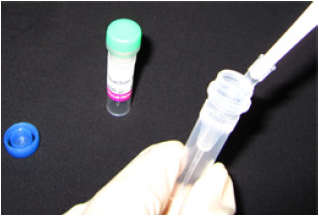
Step 1.
Prepare 50 μl of 1 mmol/l thiol compound solutiona) with Reaction Buffer. Add this solution to a tube of SH-Reactive Alkaline Phosphatase.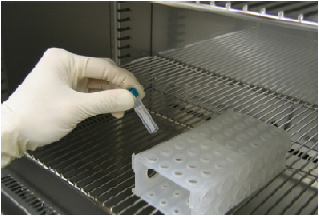
Step 2.
Pipette to dissolve SH-Reactive Alkaline Phosphatase completely, and incubate the tube at 37°C for 1 h.
-
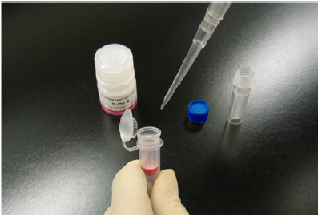
Step 3.
Add 100 μl Solution A to the reaction solution, and transfer the solution to a Filtration Tube.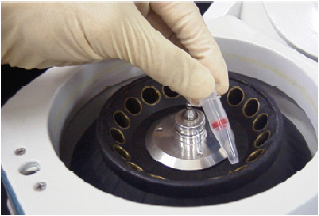
Step 4.
Centrifuge at 8,000 x g for 10 min.b)
-
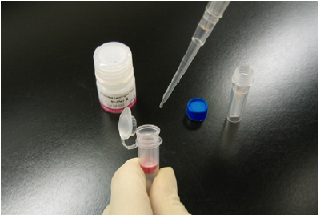
Step 5.
Discard the fi ltrate, add 200 μl Solution A to the tube.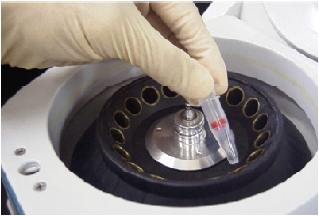
Step 6.
Centrifuge at 8,000 x g for 10 min.b)
Add 200 μl Solution A and centrifuge again.
-
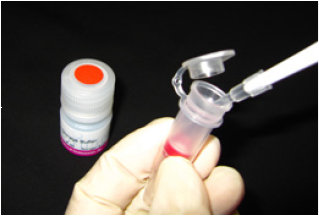
Step 7.
Add 200 μl Storage Buffer, and pipette about 10 times to dissolve the conjugate.c) Transfer the solution to a microtube (not included in this kit), and store the solution at 0-5°C.d)
a) If the thiol compound does not dissolve in aqueous solution, dissolve it with DMSO to prepare 10 mmol/l solution, and mix 5 μl of this solution with 45 μl Reaction Buffer.
b) If the solution still remains on the membrane after the centrifugation, spin for another 5 min.
c) One to two target molecules should be conjugated with one alkaline phosphatase molecule.
d) We recommend using Storage Buffer to recover the conjugate. However, you can use an appropriate buffer for the downstream experiments.
General Protocol -2
Labeling for IgG a)
-
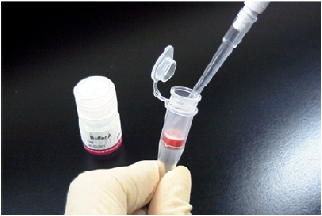
Step 1.
Add 100 μl Solution A and the sample solution containing 50-200 μg IgGb) to a Filtration Tube.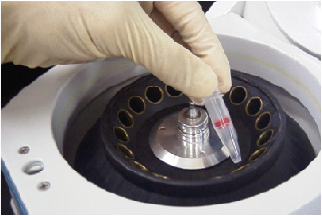
Step 2.
Pipette to mix and centrifuge at 8,000 x g for 10 min.c)
-
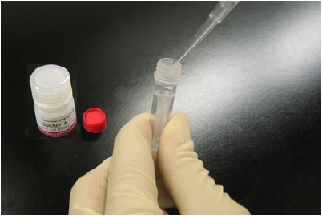
Step 3.
Add 150 μl Solution A to Reducing Agent, d)and dissolve with pipetting.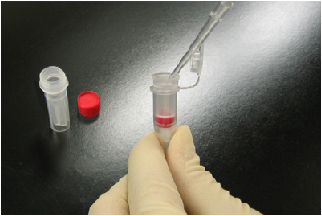
Step 4.
Transfer 100 μl the Reducing Agent solution to the Filtration Tube, and pipette to dissolve the IgG.e)
-
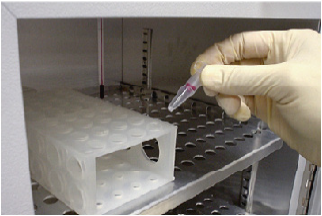
Step 5.
Incubate the tube at 37oC for 30min. Add 100 μl Solution B and centrifuge at 8,000 x g for 10 min.c)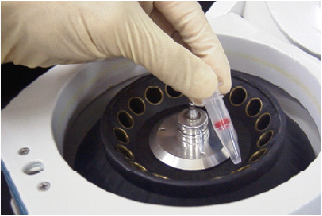
Step 6.
Discard the fi ltrate, add 200 μl Solution B and centrifuge at 8,000 x g for 10 min again.c)
-
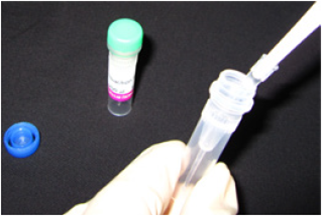
Step 7.
Add 50 μl Reaction Buffer to SH-Reactive Alkaline Phosphatase, and dissolve it with pipetting.f)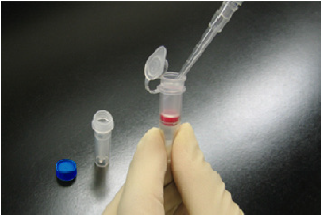
Step 8.
Add SH-Reactive Alkaline Phosphatase solution to the Filtration Tube and pipette to mix.
-
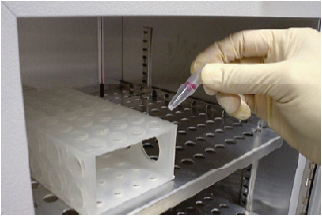
Step 9.
Incubate the tube at 37°C for 1 h.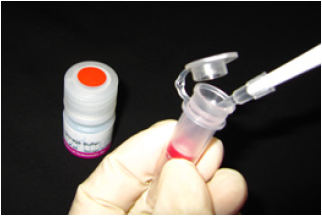
Step 10.
Add 150 μl Storage Buffer, pipette about 10 times to recover the conjugate.g) Transfer the solution to a microtube (not included in this kit), and store the solution at 0-5°C h)
a) If the target protein has free SH groups, skip the reducing procedure (Step 3-6).
b) The volume of sample solution should be less than 100 μl. If the IgG concentration is lower than 0.5 mg/ml, repeat Steps 1 and 2 until the total IgG accumulation becomes 50-200 μg.
c) If the solution still remains on the membrane after the centrifugation, spin for another 5 min.
d) The reagent may be attached to the inner wall of the cap. Please open the cap carefully.
e) The reagent may cleave a disulfi de bond of IgG except a hinge region.
f) SH-Reactive Alkaline Phosphatase is unstable in Reaction Buffer. Proceed to Step 8 immediately after the preparation of the SH-Reactive Alkaline Phosphatase solution.
g) One to two molecules of alkaline phosphatase should be introduced onto one reduced IgG molecule. Unconjugated alkaline phosphatase should not interfere with normal immunoassays. If purifi cation is necessary, use a gel permeation column or an affi nity column for IgG.
h) We recommend using Storage Buffer to recover the conjugate. However, you can use an appropriate buffer for the downstream experiments.
Q & A
Can I use this kit to label antibody which is commercially available?
Yes. However, if antibody solution contains other proteins such as serum albumin or gelatin, labeling reaction might be interfered by that proteins. Purifi cation of the antibody solution with affi nity chromatography is necessary prior to using this kit. Contact us for the purifi cation procedure, if you need.
How long is the alkaline phosphatase labeled protein stable?
The stability depends on the protein itself. In the case of labeling for goat IgG, the labeled IgG is stable at 4°C for 2 months. However, for longer storage, please store at -20°C.
Can I use this kit for other proteins or peptides?
Yes, if the molecular weight is higher than 50,000 or lower than 5,000, and it has a reactive sulfhydryl group, or a disulfi de group that can be reduced without losing activity. If the molecular weight is higher than 50,000, follow the labeling protocol for IgG, and use 50-200 μg of sample protein. If it is lower than 5,000, follow the labeling protocol for small molecules. If the molecular weight is lower than 50,000 but higher than 5,000, please contact us.
Can I use this kit to label an oligonucleotide?
Yes, if the molecular weight is less than 5,000, and it has at least one sulfhydryl group. Follow the labeling protocol for small molecules.
What is the minimum amount of IgG that can be labeled with this kit?
We recommend using 50 μg as a minimum amount. Though 10 μg IgG can still be labeled using this kit, the background will be increased.
Frequently Asked Questions / Reference
LK13: Alkaline Phosphatase Labeling Kit - SH
Revised Nov., 24, 2023


 Hidden sections will not be printed.
Hidden sections will not be printed.

